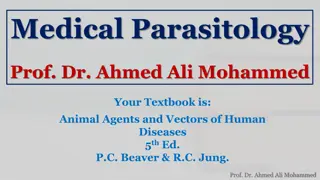Overview of Strongyloidea Parasites in Veterinary Parasitology
This informative text covers the morphology, life cycle, and common genera of Strongyloidea parasites, including Ancylostoma caninum and Bunostomum sp. It also discusses the occurrence of cutaneous larva migrans and details the Superfamily Trichostrongyloidea. Profound insights into practical parasitology are presented by Prof. Dr. Muna M. Jori through detailed descriptions and images.
Download Presentation

Please find below an Image/Link to download the presentation.
The content on the website is provided AS IS for your information and personal use only. It may not be sold, licensed, or shared on other websites without obtaining consent from the author. Download presentation by click this link. If you encounter any issues during the download, it is possible that the publisher has removed the file from their server.
E N D
Presentation Transcript
Strongyloidea Practical parasitology Prof Dr. Muna M. Jori
Strongyloidea Morphology: Large buccal Intestinal tract capsule with cutting plates or teeth. Medium size, thick body Male : bursate, Female : oviparous. Sit of infection: intestine Life Cycle: Direct 1- Larvae on the ground ingested or penetrate skin. 2- Larvae may be sequestered in tissues of host.
Common Genera: Cutting Plate Teeth Uncinaria stenocephala Unemberyonated Embryonated
Ancylostoma caninum General characteristics: -occure in the small intestine. -the host; dog, fox , wolf and other wild carnivores .rarely in man. -its cosmopolitan in distribution,being common in tropical and sub tropical zones in north America ,Australia and Asia. -The male is 10-12mm long and the female 14-16 mm long. -The worms are fairly rigid and gray or reddish in color, depending on the presence of the blood in the alimentary tract.
Bunostomum sp. General characteristics -Is a hookworm which occur in the small intestine (ileum and jejunum). -the host; sheep and goat, The male is 12-17 mm long and the female 19-26 mm. -The anterior end is bent in a dorsal direction, so that the buccal capsule opens anterodorsally -There are pair of chitinus plates, near its base is a pair of small sub ventral lancets.
C A B Bunostumum sp.: (A): anterior region with teeth, (B): posterior region of male with copulatory bursa, (C): ovum
Cutaneous larva migrans This condition may be compared with V.L.M. It occurs in human and other hosts and is caused by the larvae of nematodes which inter the skin and migrate in it ,caused papules and inflamed tracks ,sometimes with thickening of the skin and pruritus. The nematodes whose larvae may cause it: A.caninum , A.braziliense, Uncinaria stenocephala, A.duoddenale, B.phlebtomum, Strongyloides spp. and Gnthstoma spp.
Superfamily: Trichostrongyloidea Morphology: -Small, slender digestive tract body, simple mouth, small buccal cavity, male bursate, while, female oviparous. - Life cycle: Direct. Larvae on the ground ingested - Sit of Infection: Digestive tract Commone Genera: Trichostrongylus, Ostertagia, Nematodirus, Haemonchus, Obeliscoides.
Haemonchus contortus Haemonchus represent the most economically important helminthes parasites in cattle, sheep, and goats occurs in nearly all subtropical and temperate areas of the world. Adult worms are attached to abomasal mucosa and feed on blood, which causes an anemia and eventually can lead to death, making H. contortus one of the most pathogenic nematodes of ruminant.
Thank You Thank You

























